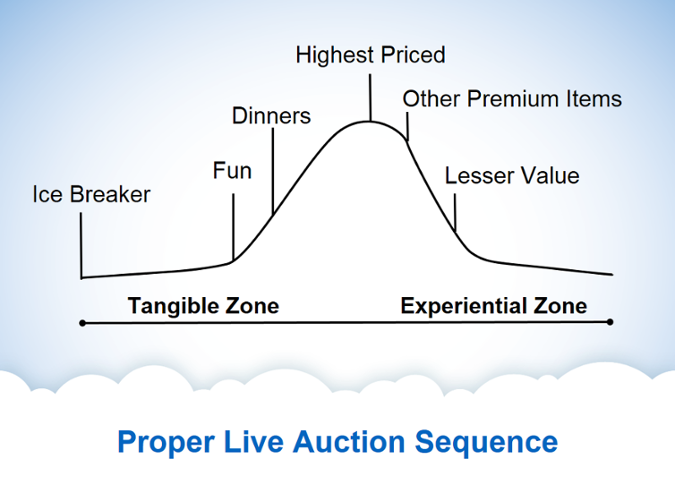Live benefit auctions can be an excellent fundraising opportunity for your Nonprofit. In order to maximize your fundraising efforts and raise the most money possible, try to avoid these five live auction pitfalls.
1. Not hiring a professional benefit auctioneer
When it comes to Nonprofit fundraising, you have to spend money to make money. Professional charity auctioneers specialize in fundraising auctions, which means they can help you throughout the planning process. An auctioneer with experience can advise you on everything from when it is best to make a special appeal to which items will work best in the live vs. silent auction.
Professional auctioneers are also going to be more effective at encouraging active bidding during the event. They have experience injecting commentary about your mission into the live auction chant, helping tug at the heartstrings of your audience. Good auctioneers will know when to be forceful with bidders and when to back down, as well as help drive more traffic to your silent auction tables.
While it may be cheaper to run the event yourself or get the most outspoken person in your office to host, hiring a professional benefit auctioneer will almost always help you raise more money.
{{cta(‘78303450-25d5-4706-9e3c-4e1c54b413a7′,’justifycenter’)}}
2. Boring your audience with a long auction
Live auctions with too many items can easily drag on, and bored guests do not bid nearly as much as those who are excited and engaged. Keep your audience’s attention by limiting the number of items in your live auction to a handful of your most sensational items, such as a signed piece of memorabilia or unique travel Experience. For most events, keeping it between 7-12 big-ticket live no-risk auction items should do the trick.
{{cta(‘eee0bd1e-ee7f-449f-822b-08d8fdab4f35′,’justifycenter’)}}
3. Presenting auction items poorly
It’s great that your organization put a lot of time and effort into decorating the event venue, but how much work did you put into presenting your auction items?
An auction is like a shopping experience for bidders, which means the presentation of each item will largely impact how desirable it is. You might think this only applies to your silent auction, but it can certainly influence your live auction as well.
Set up a separate table for tangible live items that is somehow set apart from the silent auction, whether it’s closer to the front of the room or has a different color tablecloth. Take some time to make sure this table really shines.
For intangible items, such as travel packages and experiences, put beautiful pictures and video on screen to show off their best aspects. Capture the audience’s imagination with an engaging description for all items. This will build anticipation for the live auction throughout the event.
{{cta(’80f85376-39d1-40aa-ae2a-bc4be194d7e3′,’justifycenter’)}}
4. Missing additional opportunities to raise more money
Most of your guests are attending your event with the intention to spend money, but not all of them will be successful bidders. Give these donors the chance to support your mission in other ways.
One of the best ways is to have your auctioneer make a special appeal or perform a “Fund-A-Need” to draw direct donations at some point during the event. Try to close down your silent auction before you make your special appeal. That way guests who tried bidding during the live and silent auctions but didn’t end up win any items will still have an opportunity to contribute. This is a good reason to close off the silent auction early, before the live auction begins.
{{cta(‘3dd4718e-77dc-49d5-a5e6-0b3ccde90e1b’,’justifycenter’)}}
5. Saving the best item for last
It may seem like a good idea to present your most sensational items last to create excitement and build anticipation, but this can actually have the opposite effect. Guests have a tendency to spend more money when they see others spending money, and delaying your best items will deter your bigger bidders from participating until the end.
When your big bidders are not spending money during the event, this can have a negative affect on audience engagement and drive down bidding. Furthermore, with only tepid bidding happening during the event, it’s going to be more difficult to ignite enthusiasm from the audience at the very end.
 Instead, start and end your auction with lower-value items and sell off your best items mid-way through (usually second half), when excitement is at its peak. This will keep your audience engaged and the money flowing throughout the event.
Instead, start and end your auction with lower-value items and sell off your best items mid-way through (usually second half), when excitement is at its peak. This will keep your audience engaged and the money flowing throughout the event.
{{cta(‘2493c44f-abf9-49d3-8678-cf7059e8567b’,’justifycenter’)}}
If you’ve had trouble with live auctions in the past, consider these top pitfalls when planning your strategy in the future. Some minor tweaks here and there can have a huge impact on your success!
